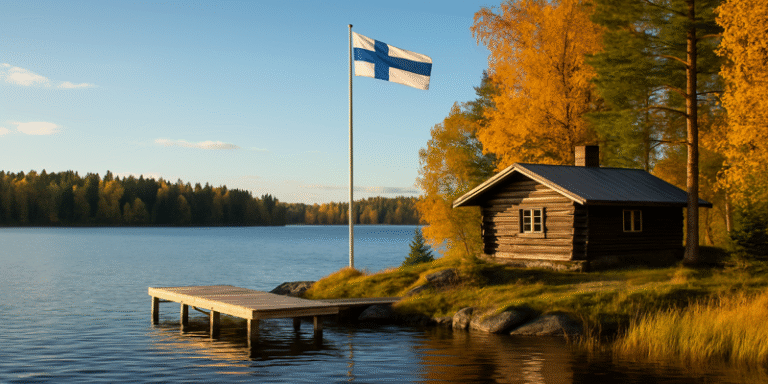Each year, the World Happiness Report ranks countries by levels of happiness, using criteria such as social support, life expectancy, freedom, generosity, and corruption. For several years in a row, Finland has consistently topped this list (Martela et al., 2020). But what makes this Nordic nation the happiest country on Earth? This article explores the unique blend of social policy, culture, governance, and lifestyle that underpin Finland’s reputation for well-being and contentment.
The Pillars of Finnish Happiness
1.0 Social Welfare Model
At the heart of Finland’s happiness lies a robust welfare state. Finnish social policy is based on the Nordic model, which emphasises universal services, high taxation, and egalitarianism (Rothstein, 2010). Citizens receive free healthcare, tuition-free education, and generous parental leave policies—systems designed not just for survival but to promote flourishing.
Olafsson (2013) describes the Nordic welfare systems as “protection against life risks,” and Finland excels in safeguarding its citizens through comprehensive social safety nets. This contributes directly to reduced stress, better mental health, and greater life satisfaction.
“The Finnish model empowers citizens rather than creates dependence” (Kouvo & Räsänen, 2015, p. 112).
2.0 Trust and Low Corruption
Another reason Finns report high levels of happiness is institutional trust. Finland has exceptionally low levels of corruption and strong civic institutions. According to Helliwell et al. (2020), the perception of fair governance and low inequality helps people feel safe and secure in their daily lives.
A transparent government builds public confidence and ensures resources are efficiently distributed. The rule of law is respected, and bureaucracy is user-friendly—creating a sense of autonomy and control over one’s life (Rothstein, 2010).
3.0 Education and Lifelong Learning
Finland’s education system is globally renowned—not only for academic performance but for fostering well-being among students. It minimises pressure, values creativity, and encourages holistic development. Teachers are highly qualified and well-respected, and children are rarely given homework in early years (Andersson, 2022).
According to Tenhunen (2020), Finnish education doesn’t merely prepare for jobs—it cultivates a sense of purpose, community, and lifelong curiosity, which are foundational to long-term happiness.
4.0 Cultural Attitudes and Lifestyle
One cannot discuss Finnish happiness without understanding their cultural mindset. The concept of “sisu”—a unique Finnish term—refers to a mix of resilience, stoic determination, and grit in the face of adversity (Tenhunen, 2020). Finns value simplicity, modesty, and quiet strength, avoiding flamboyance and focusing instead on what truly matters.
Nature also plays a critical role. With 75% forest cover and over 180,000 lakes, nature-connectedness is a daily experience. Activities like forest bathing, ice swimming, and sauna culture are embedded in Finnish life and shown to enhance mental well-being (Backman-Nord et al., 2022).
5.0 Work-Life Balance
In contrast to hyper-productivity seen in many Western economies, Finland champions work-life balance. Working hours are shorter, flexible work arrangements are common, and family life is prioritised. This prevents burnout and nurtures social connectedness, a known factor for happiness (Brulé & Veenhoven, 2014).
Research from Diener et al. (2018) indicates that quality of relationships, not material wealth, is the strongest predictor of happiness. In Finland, the culture of community and mutual respect supports this.
6.0 Youth and Education Well-Being
Even among university students, who typically face stress and uncertainty, Finland reports some of the highest subjective well-being levels in the world. A study by Backman-Nord et al. (2022) found that Finnish youth felt supported not just by family and institutions, but by a collective ethos that values mental health.
Unlike many countries, Finnish policies include well-funded mental health services in education systems, promoting resilience from an early age (Kainulainen, 2023).
7.0 Equality and Inclusion
Gender equality, LGBTQ+ rights, and social inclusion are widely supported in Finnish society. The Global Gender Gap Report consistently places Finland in the top tier globally for gender parity. These achievements stem from progressive policies and a culture of consensus-building, allowing for a more cohesive society (Pellikka & Hätönen, 2025).
As Martela et al. (2020) explain, the Nordic exceptionalism is not based solely on wealth, but on “how societies use their wealth to support human flourishing.”
8.0 Freedom and Autonomy
The feeling of freedom to make life choices is one of the strongest predictors of happiness in the World Happiness Report. Finland performs especially well in this category. The government’s role is seen not as paternalistic, but as facilitating individual autonomy.
Martela et al. (2020) argue that personal freedom, when coupled with strong social infrastructure, leads to a healthy balance between individual agency and community belonging.
A Blueprint for the World?
Finland’s happiness is not a fluke or cultural curiosity—it is the outcome of intentional policies, social values, and a collective mindset that prioritises well-being over mere economic output.
As global interest in gross national happiness rises, Finland’s example serves as both aspiration and inspiration. While not every element of the Finnish model may be replicable, key principles—such as universal education, trust in institutions, equity, and connection to nature—are adaptable across borders.
In the end, Finland teaches us that happiness is not a pursuit but a practice—rooted in care for others, simplicity, and sustainability.
References
Andersson, J.O. (2022). Explaining Finnish economic and social success – And happiness. Studia Europejskie, 4, pp.112–125. [Available at: https://www.ceeol.com/search/article-detail?id=1097938].
Backman-Nord, P., Söderberg, P. & Forsman, A.K. (2022). The happiest youth in the world? Exploring subjective well-being indicators among Finnish university students. Nordic Psychology, [online] Available at: https://www.tandfonline.com/doi/abs/10.1080/19012276.2021.1996264.
Brulé, G. & Veenhoven, R. (2014). Freedom and happiness in nations: Why the Finns are happier than the French. Psychology of Well-Being, 4(17). [https://link.springer.com/content/pdf/10.1186/s13612-014-0017-4.pdf].
Diener, E., Biswas-Diener, R. & Lyubchik, N. (2018). Social well-being: Research and policy recommendations. In Global Happiness Report, pp. 130–140. [https://www.academia.edu/download/56745257/globalhappiness_report_2018.pdf].
Kainulainen, S. (2023). In the Backyard of Finnish Happiness – Empirical Observations from the Happiest Country on Earth. [https://www.theseus.fi/handle/10024/809540].
Kouvo, A. & Räsänen, P. (2015). Foundations of subjective well-being in turbulent times: A comparison of four European countries. International Journal of Sociology and Social Policy, 35(1/2), pp.106–123.
Martela, F., Greve, B., Rothstein, B. & Saari, J. (2020). The Nordic Exceptionalism: What explains why the Nordic countries are constantly among the happiest in the world? In World Happiness Report 2020. [https://forskning.ruc.dk/files/75303141/World_Happiness_Report_2020.pdf]
Olafsson, S. (2013). Well-being in the Nordic Countries: An international comparison. Stjórnmál og stjórnsýsla, [PDF] Available at: https://www.researchgate.net/publication/269624806
Pellikka, R. & Hätönen, H. (2025). Wellbeing and Policy in Finland. OAPEN Library. [https://library.oapen.org/handle/20.500.12657/101157]
Rothstein, B. (2010). Happiness and the welfare state. Social Research: An International Quarterly, 77(2), pp.441–468.









